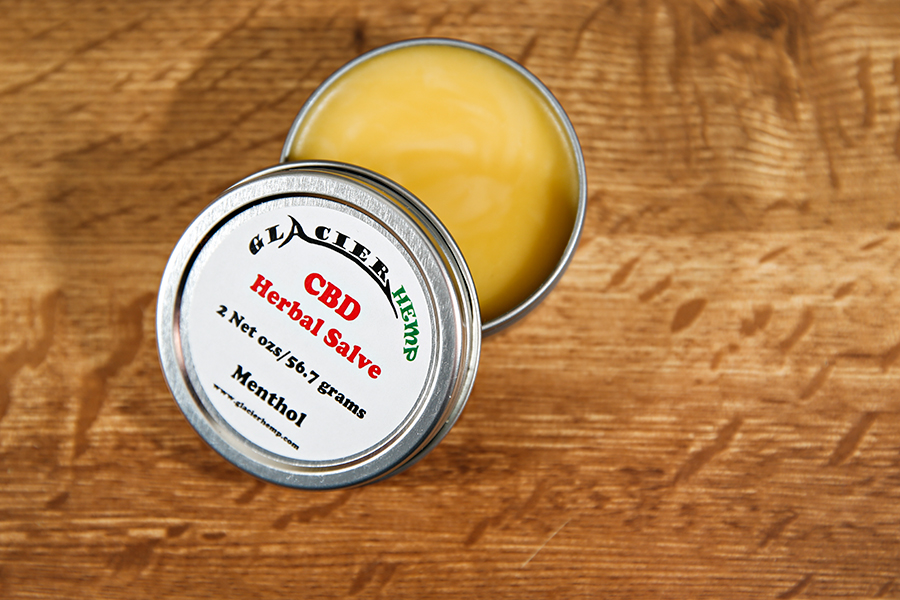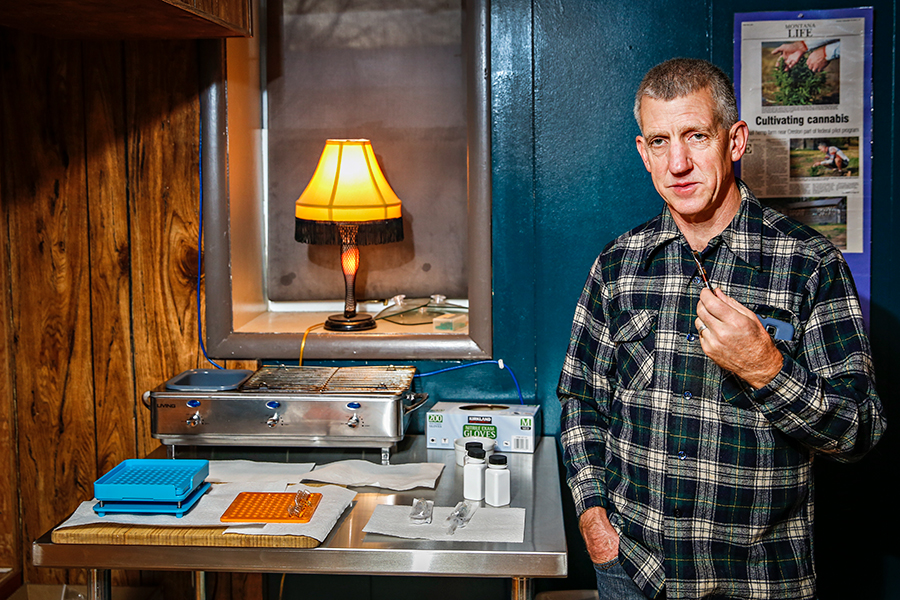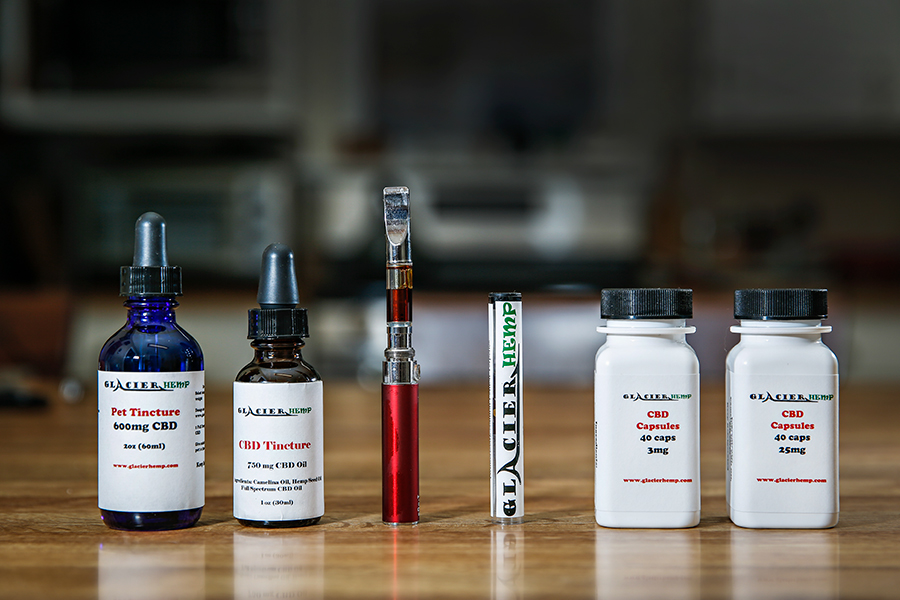As soon as the 2018 Farm Bill lifted a ban that had classified hemp as a federally controlled substance, Cori Monatukwa set aside a 5-acre plot on his land in Polson, planted 2,000 cannabis plants and started his business, Montana Grown Hemp.
He promptly lost 95 percent of his crop and $3,000.
A combination of harsh Montana weather, seed germination failure and grasshopper infestations resulted in an almost complete flop. But Monatukwa isn’t letting his failed trial run dash his hemp production dream. He plans to next year grow 50 to 100 acres of hemp scattered across western Montana, from Polson down south to Dixon and Stevensville.
Monatukwa will process the plant for hemp seed oil, an alternative to olive oil, as well as hemp-based beads, bolo ties and even cat toys. He also will process the hemp for cannabidiol, or CBD, a popular oil that users say has benefits for ailments, including anxiety, depression and seizures.
“My goal is to have a 100 percent Montana-grown product,” Monatukwa said.
Prior to the 2018 Farm Bill, hemp was classified as a controlled substance on the federal level, meaning it was illegal to grow. The 2014 Farm Bill allowed hemp production under specific conditions in certain states, with Montana joining the hemp market in 2017. But growers like Monatukwa were hesitant to start up before it became legal at the federal level.
“In 2017 there were a lot of hoops you had to jump through,” Monatukwa said. “In 2018, it allowed me to be federally legal.”

Long before hemp was criminalized in the U.S. along with its close relative, marijuana, in 1937, the plant was widely produced. In the 17th century, hemp was used for rope, sails and clothing. The 1619 Virginia Assembly even passed legislation that required every farmer to grow hemp.
But in the early 1900s, following the Mexican Revolution, immigrants introduced the recreational use of marijuana to Americans. The entire plant became associated with a negative image of immigrants and its perceived link to crime and violence.
Once “Reefer Madness” hit the screens in 1936, it was all over for cannabis. The 1937 Marijuana Tax Act criminalized marijuana and labeled it as a narcotic. The “evil weed” campaign had proven successful, bringing marijuana and hemp down together. Even though hemp contains very little tetrahydrocannabinol (THC), the psychoactive chemical in marijuana, it wouldn’t become legal again for almost 80 years.
Under the 2018 Farm Bill, hemp was removed from the ban, allowing farmers nationwide to grow the crop for production as an agricultural commodity. The legislation established a hemp production framework that allowed states and Indian tribes to submit plans to the U.S. Department of Agriculture (USDA).
The Hemp Farming Act of 2018, the name of the legislation folded into the Farm Bill, had bipartisan support. Rep. James Comer, a Republican from Kentucky, introduced the bill, and Sen. Jon Tester (D-Montana) and Sen. Steve Daines (R-Montana) both supported it.
Last month, as required by the Farm Bill, the USDA announced the establishment of the U.S. Domestic Hemp Production Program, which creates national standards for hemp regulations, including licensing and sampling requirements. An interim rule formalizing the program was then published in the Federal Register and will become final following a 60-day public comment period.
The USDA says the program creates “a consistent regulatory framework around hemp production throughout the United States.”
“At USDA, we are always excited when there are new economic opportunities for our farmers, and we hope the ability to grow hemp will pave the way for new products and markets,” U.S. Secretary of Agriculture Sonny Perdue said on Oct. 29.
Daines and Tester both praised the program’s establishment.
“Hemp in Montana is a great opportunity to create Montana jobs and grow Montana Ag,” Daines, a member of the Senate Agriculture Committee, said in a press release. “I am glad to see Secretary Perdue and USDA move this process forward with the creation of the Hemp Production Program which will help provide regulatory certainty for Montana farmers interested in hemp production.”

Even before the 2018 Farm Bill was passed, Montana alone produced 22,000 acres of hemp out of the 78,176 acres grown nationwide in 23 states participating in the pilot program, making Montana the leader in hemp production, according to Vote Hemp.
Hemp acreage in Montana more than doubled in 2019 following the Farm Bill, with 51,000 acres planted and 277 grower’s licenses issued this year, according to Andy Gray, the Hemp Program Coordinator for the Montana Department of Agriculture.
While hemp and marijuana are both derived from Cannabis sativa L., the USDA defines hemp as a plant with no greater than .3 percent THC. Once a hemp plant contains more than .3 percent THC, it’s defined as marijuana.
States are required to monitor THC levels to ensure they are below .3 percent. Officials from Montana’s agriculture department take samples from individual crops a few weeks before harvest, which are sent to the Montana Department of Agriculture analytical lab at Montana State University in Bozeman.
As long as THC levels don’t exceed the limit, growers can begin processing. If they do, the plants must be discarded and the farmer must file a corrective plan with USDA.
While Monatukwa passed the sampling test and got the green light to start production, a neighboring hemp farmer outside of Whitefish, Cory Waggoner, failed. Like Monatukwa, Waggoner started growing hemp a few months after the federal ban was lifted. He too used his first year growing as a trial period, planting only a half-acre plot of hemp and 500 plants indoors.
Though his outdoor plants didn’t fair well with Montana’s early winter intrusion this October, which resulted in high winds and record low temperatures, his indoor plants did well. But even with his successful indoor plants, his business, Bigsky Hemporium, took a hit when he failed the state’s sampling test, which was the first test done statewide.
But Waggoner believes the state was using the wrong test to determine accurate THC levels. He says the state uses a THC acid conversion test when it should be using a delta-9-tetrahydrocannabinol test.
“They’re just doing the wrong test,” Waggoner said. “They don’t really know what’s going on; nobody does. I’m not trying to blame them.”
He thinks testing should be conducted on the final product instead of the harvested plant. “It’s all about what’s going out to the public, not the plant you’re harvesting,” he said.
In addition to farming hemp, Waggoner also processes the plant himself for CBD, which has found a growing market both in Montana and nationwide. He uses a decarboxylation process, which he turns into CBD tinctures, and he also sells the flower by itself.

CBD users claim the hemp-derived product results in numerous health benefits, including pain relief, anxiety and seizures. But there is very little available research to prove scientific health benefits. According to the Food and Drug Administration, Epidiolex is the only FDA-approved CBD product, which is used for two rare forms of epilepsy, Lennox-Gastaut syndrome and Dravet syndrome, and is approved for patients over age 2.
“I’m not really allowed to say that it cures or fixes any diseases or ailments,” Waggoner said. “But I’ve literally never given it to someone who said it didn’t help them in some way.”
Kalispell-based hemp entrepreneur Joe Arnone says more CBD research should be completed to clarify its benefits and to make it less stigmatized since it’s so closely associated with marijuana.
“We need to work together with the pharmaceutical industry,” he said, calling the industry’s studies “really beneficial to people.”
Arnone makes CBD formulas for his business, Glacier Hemp, out of his home in Kalispell, which he uses in capsules, salves, tinctures, vaporizer cartridges and oils. He also makes hemp seed oil, hemp seed hearts and hemp seed protein powder.
Like Waggoner, Arnone says the FDA regulations don’t allow him to make any claims about his products.
“If you have joint pain and you put it (CBD) on and it feels better, you can’t say it makes it better,” Arnone said about the regulations.
He says with more studies, the FDA can work toward approving all CBD products and make them more mainstream.
“They need to find out what it’s best for,” Arnone said.
Meanwhile, other hemp farmers are growing the plant for different uses.
According to the North American Industrial Hemp Council, hemp can be used for 25,000 products, including textiles, furniture, cosmetics and construction supplies. Monatukwa plans to use the plant for its fibers as well as for CBD products. Monatukwa is exploring other hemp uses because the FDA’s oversight of CBD is so stringent.
“If you’re not doing seed flower or oil, it’s really seriously regulated and scrutinized,” Monatukwa said.
Arlin Fratzke, a cattle rancher turned hemp farmer in Stevensville, isn’t going into the CBD business at all. He’s focusing his energy primarily on hemp seed oil. He believes the future is in the rest of the plant, not just the bud where the CBD comes from.
“The money right now is in CBD oil — everybody’s chasing that dollar,” Fratzke said. “There’s so much more that’s left in the plant besides CBD oil.”
After the Farm Bill passed, Fratzke planted a 20-acre plot of hemp as an experiment to test its feasibility. Like many Montana hemp farmers, Fratzke’s crops struggled. He overwatered his plants with his flood irrigation system, which killed most of the crop.

Although his hemp failed, Fratzke learned from the experience and plans to get rid of all his cattle and focus on farming hemp on his 100-acre ranch in the Bitterroot Valley.
Gray with the state agriculture department says farmers are gravitating toward the crop because they’re excited about the new plant’s potential.
“Adding another crop to the rotation always helps and not putting all your eggs in the same basket,” Gray said.
Like Fratzke, Gray says the experimental year hasn’t stopped other farmers from staying positive for next year.
“I think farmers in general have a positive attitude,” Gray said.
Since hemp is new, farmers still have to learn the best farming methods for their plant. Gray thinks developing seed varieties that are more conducive to a shorter grow season would help Montana farmers produce a successful plant. Smaller acreage and shorter links would also help plants, he said.
In addition to farming challenges, Fratzke says there’s a lack of processing facilities in Montana for that part of the plant to transform it into products other than CBD. Gray says the state recently initiated processor licenses in Montana and has received significant interest, but Fratzke, who sits on the state Hemp Advisory Board, says only three processing plants are under construction.
Monatukwa plans to add a processing facility called Flathead Lake Hemp in addition to his grow business. But nothing has been implemented yet, and while he has high hopes, both of his businesses futures are unknown.
With many kinks that still need to be worked out in the industry, Monatukwa says hemp could have widespread benefits for Montana and he’s willing to work through the challenges.
“Even with 95 percent (failure), I feel successful because I’ve grown hemp and now I can do it better next year,” Monatukwa said.
